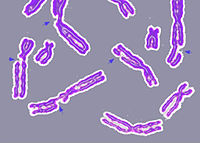
Photo from wikipedia
ABSTRACT Non-caloric artificial sweeteners have been widely permitted as table sugar substitutes with high intensities of sweetness. They can pass through the intestinal tract without significant metabolization and frequently encounter… Click to show full abstract
ABSTRACT Non-caloric artificial sweeteners have been widely permitted as table sugar substitutes with high intensities of sweetness. They can pass through the intestinal tract without significant metabolization and frequently encounter the gut microbiome, which is composed of diverse bacterial species and is a pool of antibiotic resistance genes (ARGs). However, little is known about whether these sweeteners could accelerate the spread of ARGs in the gut microbiome. Here, we established an in vitro conjugation model by using Escherichia coli that carries chromosome-inserted Tn7 lacIq-pLpp-mCherry and plasmid-encoded gfpmut3b gene as the donor and murine fecal bacteria as the recipient. We found that four commonly used artificial sweeteners (saccharin, sucralose, aspartame, and acesulfame potassium) can increase reactive oxygen species (ROS) production and promote plasmid-mediated conjugative transfer to the gut microbiome. Cell sorting and 16S rRNA gene amplicon sequencing analysis of fecal samples reveal that the tested sweeteners can promote the broad-host-range plasmid permissiveness to both Gram-negative and Gram-positive gut bacteria. The increased plasmid permissiveness was also validated with a human pathogen Klebsiella pneumoniae. Collectively, our study demonstrates that non-caloric artificial sweeteners can induce oxidative stress and boost the plasmid-mediated conjugative transfer of ARGs among the gut microbiota and a human pathogen. Considering the soaring consumption of these sweeteners and the abundance of mobile ARGs in the human gut, our results highlight the necessity of performing a thorough risk assessment of antibiotic resistance associated with the usage of artificial sweeteners as food additives.
Journal Title: Gut Microbes
Year Published: 2022
Link to full text (if available)
Share on Social Media: Sign Up to like & get
recommendations!